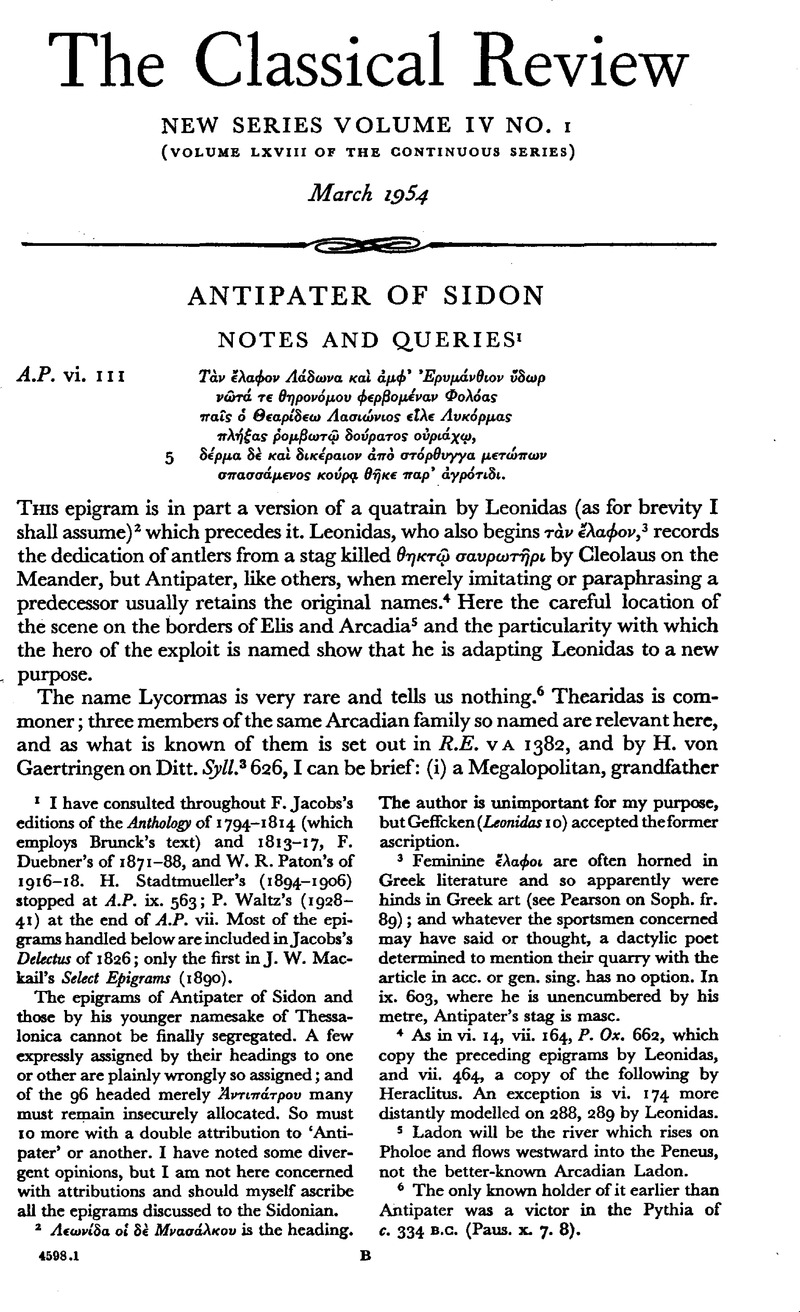No CrossRef data available.
Article contents
Antipater of Sidon: Notes and Queries1
Published online by Cambridge University Press: 13 February 2009
Abstract

- Type
- Review Article
- Information
- Copyright
- Copyright © The Classical Association 1954
References
page 1 note 2 Λεωνίδα οἱ δὲ Μναάλκου is the heading. The author is unimportant for my purpose, but Geffcken(Leonidas 10) accepted the former ascription.
page 1 note 3 Feminine ἔλαφοι are often horned in Greek literature and so apparently were hinds in Greek art (see Pearson on Soph. fr. 89); and whatever the sportsmen concerned may have said or thought, a dactylic poet determined to mention their quarry with the article in acc. or gen. sing. has no option. In ix. 603, where he is unencumbered by his metre, Antipater's stag is masc.
page 1 note 4 As in vi. 14, vii. 164, P. Ox. 662, which copy the preceding epigrams by Leonidas, and vii. 464, a copy of the following by Heraclitus. An exception is vi. 174 more distantly modelled on 288, 289 by Leonidas.
page 1 note 5 Ladon will be the river which rises on Pholoe and flows westward into the Peneus, not the better-known Arcadian Ladon.
page 1 note 6 The only known holder of it earlier than Antipater was a victor in the Pythia of c. 334 B.C. (Paus. x. 7. 8).
page 2 note 1 See on him R.E. xiii. 2386.
page 2 note 2 The epigram is headed only Ἀντιπάτρου, but is unlikely to be by the Thessalonican; vii. 493 on the same theme, though ascribed to him, seems also likely to be by the Sidonian.
page 2 note 3 de orat. iii. 194. The dramatic date of the dialogue is 91 B.C.
page 2 note 4 Val. Max. i. 8. 16, Plin. N.H. vii. 172.
page 2 note 5 See Olympische Forsch. i. 154; A.J.A. xliii. 195; Johrb. xxvii. 185; Daremberg and Saglio, iii. 36.
page 2 note 6 Il. x. 153; Arist. Poet. 1461a3 indicates that this was not a common use in his time.
page 2 note 7 Polyb. vi. 25. 6, xi. 18. 4; Suid. s.v. σαυρωτῆρσι.
page 2 note 8 Hdt. vii. 41.
page 2 note 9 Beazley kindly calls my attention to Benndorf and Niemann, Heroon v. Gjölbaschi, pl. 8, and Ant. Bosph. Cimm., pl. 46 (the Xenophantus vase), where men hunt with butted spears. I doubt however whether these are real exceptions. The quarry in each case is a boar (in the first case the Calydonian), and anyone expecting to encounter a charging boar might very prudently prefer to take out his heavier military weapon. Xenophon indeed (Cyn. 10. 3, 16) recommends a special spear with projections behind the blade to prevent the boar making his way to the hunter up the shaft of the spear.
page 3 note 1 It is a votive offering of about 500 B.C. with a dedication in the Arcadian dialect, and has a band of ivy-pattern round the socket; see A.J.A. xliii. 193.
page 3 note 2 Mackail suggested ῥομβητῷ, whirled or hurled, and I had thought of the gen. of the same word. In Suidas, where the line is cited s.vv. οὐρίαχος and ῥόμβεῖν, the manuscripts in both places offer ῥόμβῳ τῷ and τοῦ, and, in the first, τό. However, though this word would explain how the weapon was used, it would not explain why.
page 3 note 3 Kaibel (Philodemus vi), in spite of the heading and Meleagrian context in A.P., ascribed the epigram to A. of Thessalonica on the ground that it was not sufficiently elegant for the Sidonian. Kaibel overestimated the latter, but even so this seems a precipitate sentence on three couplets of which one is unintelligible.
page 4 note 1 Cic. de orat. iii. 194.
page 5 note 1 This epigram is ascribed in A.P. and plan. to Antipater without ethnic. A.P. repeated the heading when the epigram spread on to the opposite page and there added Θεσσαλονικέως, but, as is generally agreed, wrongly.
page 5 note 2 Diog. L. vi. 22.




